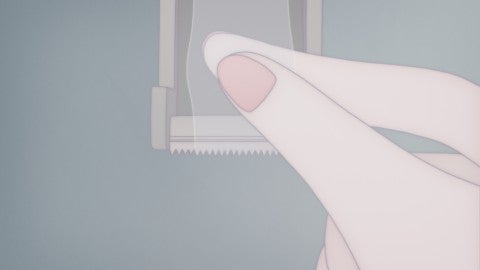In her films, installations, designs, and music videos Yoriko Mizushiri offers innovative perspectives on body parts and bodily sensations. One of her earliest videos, Shiri-play (2005), combines live action and animation, as her finger draws a pair of legs with a single black line that she tries to keep from floating off the paper. The legs split, multiply, and peel away, but Mizushiri’s finger gently pulls them back to the center of the screen until they finally disassemble and escape her grasp.
This video cemented Mizushiri’s signature minimal style, captivating viewers in a straightforward manner. She explains, "I don’t like when animations show the effort of the creator in an obvious way…. Only the important factors can exist on screen. By getting rid of those things and making the artwork raw, then it becomes pure work." Mizushiri went on to create Kappo (2006), Enyogu (2007), and Lena Lena (2009), establishing her reputation while still a student at Joshibi University of Art and Design in Japan and as a member of the Shiripiro production collective.
Her works became more ambitious while maintaining an uncomplicated appearance. Mizushiri’s trilogy focusing on the sense of touch continues to embody this simplicity. The animations Futon (2012), Snow Hut (2013), and Veil (2014) are intricate, but the drawing follows very simple lines and features unassuming pastel colors, directing the viewer’s attention to flow and motion. Partly figurative and partly geometric, the videos explore various touches—small daily pleasures like the warmth of the bed and the softness of the carpet, as well as painful sensations like stings and needle pricks. Mizushiri has stated she aims to create a feeling: "The main key of my animated work is the touch you feel through the animation.”
In Anxious Body, Mizushiri continues her examination of the sense of touch but with a less whimsical approach than seen in her earlier works. The five-and-a-half-minute video, which premiered at the Directors' Fortnight at the 2021 Cannes Film Festival and received a Jury Distinction in the Short Film section at the 2022 Annecy Festival, shows a string of wondrous yet disturbing scenarios. A finger emerges to pull a piece of tape from a dispenser, which sticks to the finger, initiating a series of interactions between various objects and beings.
The video transitions between wide shots and close, intimate views that heighten the intensity of surreal, fantastical actions. The tape pulls a finger back to attach to the forked tongue of a snake, which gets severed by the dispenser. A hand clicks a mechanical pencil to extend the lead to an extreme length that resembles a syringe ready for injection. A finger presses against tennis racket strings, a hand squeezes a triangular sponge, and the snake slithers through an amorphous, multi-limbed figure.
Mizushiri remarked that she has "been making tactile animations in the past, focusing on the softness and how it moves in a pleasant chain reaction. This time, [she] wanted to add something like ‘distortion’ to it and go in a direction that was a little different from [her] previous works." The anxiety builds with the appearance of a hangnail on the finger. Tape attaches to the piece of skin, which also runs along the body of the snake. The pace of the imagery also increases as we watch the various elements pull, poke, bounce on, hit against, and slide across each other. The disquieting activity culminates in a painfully satisfying moment when the tape sharply snaps off the hangnail.
Accompanied by a spare, eerie score of strings and synths, the simply drawn, softly colored imagery and interactions fluctuate between satisfying to unsettling throughout Anxious Body. For instance, the tape dispenser not only cuts tape but also a snake’s tongue; the sponge playfully bounces off racket strings that later ensnare a body; and the innocuous sticking of tape ultimately rips skin from a finger. Mizushiri’s work thus captures the paradoxical nature of anxiety, which emerges from both fear and desire.
Anxiety also is often experienced first and more through the body than recognized or understood by the mind. Mizushiri invites viewers to interpret the work in this way: “It's a tactile animation work, so I'm happy if you can feel something in your body being evoked, like ‘I understand this movement,’ or ‘I've felt this before.’” Yet despite the familiarity of sensations such as squeezes, pushes, and pulls, Anxious Body lives up to its name, never allowing the viewer to feel too comfortable. —Kanitra Fletcher

